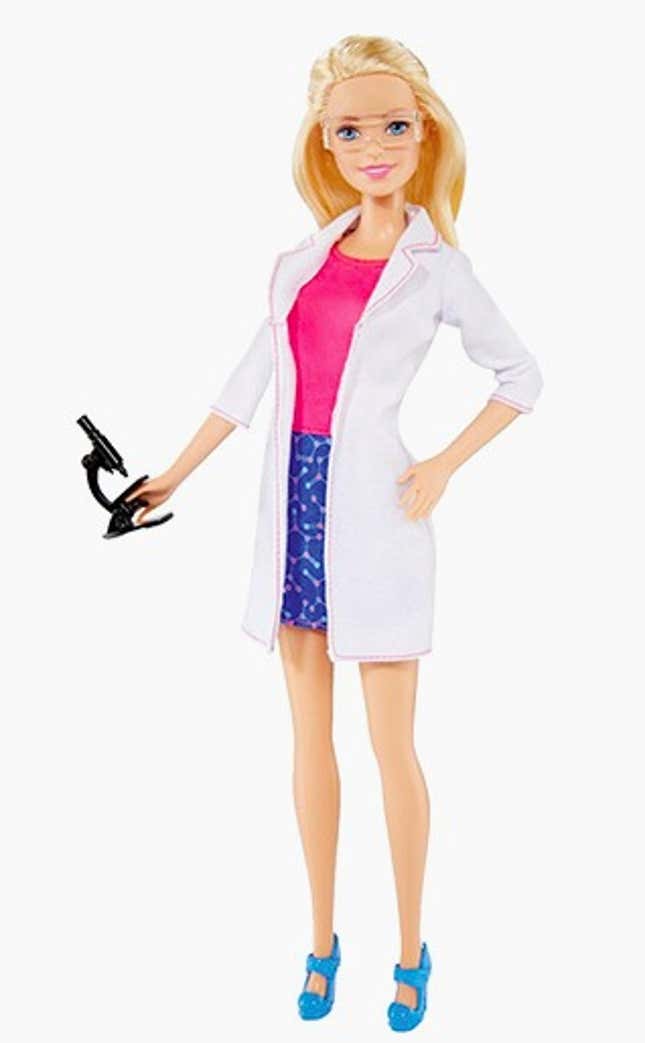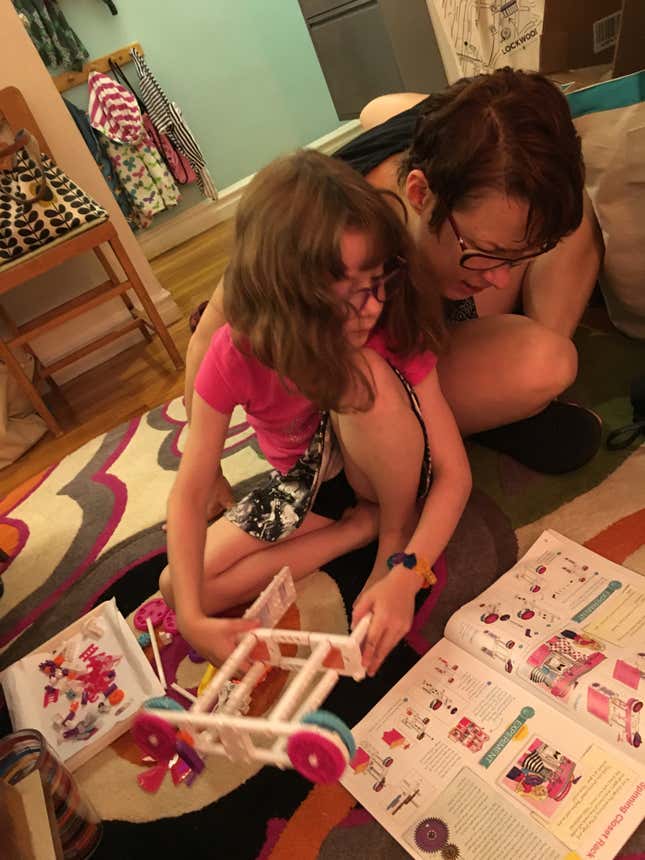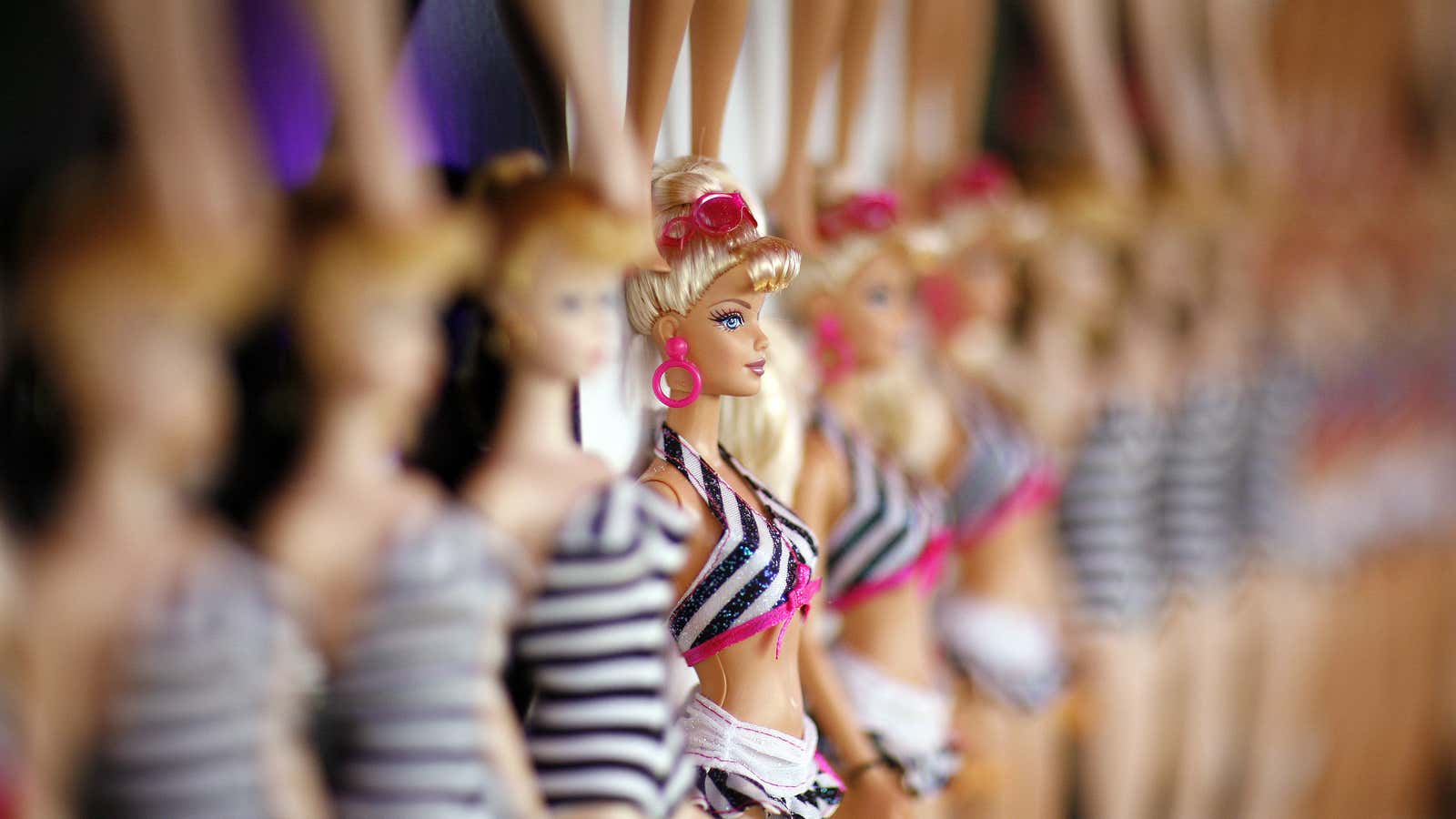Feminist parents will likely cringe upon hearing that there’s a new Barbie STEM Kit. Two years ago we were burned by Barbie: I Can Be a Computer Engineer, a story in which Barbie was designing a video game but needed two male classmates to turn it into a “real game.”
Thankfully, there isn’t a Ken doll in the set to do Barbie’s science experiments for her, but there is a spinning closet rack, a rotating shoe rack, and even a washing machine.
While it’s easy to find fault with those gendered appliances, the new Barbie offers something any parent can get behind: a premium science experience.
Can fashion-inspired engineering be taken seriously?
The best engineering toys aimed at girls embrace how they play and integrate science into that play. This kit is no different. Barbie is using science to make her life better.

Through a guide that is part-storybook and part-instruction manual, she is presented with various dilemmas and works with her friend, an African American doll named Nikki, to build a solution. (And identical STEM Kit featuring Nikki is also for sale.) This is ideally how prototyping begins—by having a problem and trying to build a solution. The very first activity is building a spinning clothes rack. After building the rack, the manual encourages kids to contemplate the functionality of the design. Through the step-by-step process, children learn that not all gears work the same way. The following experiment (for the same spinning closet rack) shows how a small gear can increase the torque (turning force), but a larger gear may make something turn faster. (See above graphic)
A highly creative 7-year-old girl tested this for me. She was happy to build a spinning closet rack for all of her Barbie clothing.

Even though her father is an engineer, and she’s had plenty of coding practice already, she didn’t have much exposure to building pieces such as the ones in the Barbie STEM Kit because they aren’t ordinary building blocks like LEGO bricks or Lincoln Logs. They are traditional mechanical building pieces that include elements such as sprockets, gears, axles, rods, pins, etc. That said, with assistance, she was able to put together the spinning closet rack, and she was very pleased to hang up her doll’s dresses on the rack.
Clothing-related machines turn out to be great examples of how to teach basic physics and mechanical engineering concepts. Unique as it was, the rotating shoe rack aptly demonstrated the mechanics of a gear chain, which a child can relate to other things in her life including her bicycle.
The best girls’ science toys raise the bar for all science toys
While many girl-focused building toys seem to be a pink version of an existing product, some have really raised the bar. Last year, Roominate, a building toy geared towards girls, in only its third year of production, made a very special contribution by creating a product that offered bluetooth-controllable circuits in a building toy for children as young as six.
That said, advanced tech isn’t the only way girls’ science toys make improvements. New characters introduce new ways to learn basic concepts and that can increase accessibility. For example, Barbie’s kid-sized necklace and accessory holder can even spin, which then is a great way to explain centripetal force. In the past, this had mostly been done in children’s kits via amusement park models. The kit also features a washing machine model, which unveils and demystifies the mechanics of something kids see in their homes daily. That’s smart teaching.

Traditionally, even within Thames and Kosmos’ extensive line of science kits (over 140 according to their website), there aren’t really any all-encompassing STEM kits. Most science kits in the market are usually broken down by category such as chemistry, solar energy, etc. Thus, a conscientious shopper will find that the kit offers a rare chance to engage in a variety of STEM learning for a very fair price ($29.95) since the Barbie STEM kit explores not only building, but also chromatography, botany, and even optical illusions. Moreover, the building pieces in the STEM Kit are completely compatible with Thames and Kosmos’ existing building sets for ages five and up. That means Barbie STEM Kit owners can move forward to discover anything from robotics, physics, pneumatics, or hydraulics using pieces from her original set.
Barbie STEM Kit is not perfect and most science kits aren’t anyway
Before assuming that the Barbie STEM Kit will be the gateway kit to science heaven, parents who are new to science kits should be aware of its limitations, which it shares with many science toy kits. These kits usually require parental involvement, and many parents, including myself, still struggle with this. It’s not easy guiding a 6-year-old to follow directions or to start getting creative without instructions. Additionally, this STEM Kit suggests that the appropriate ages are 4- to 8-years-old, but no parent of a preschooler should expect independent play with this kit. Our tester, 7, was able to put things together but needed assistance to make everything fit snugly, which is needed when running a mechanical experiment.

Moreover, it needs to be said that this kit, which has created Barbie’s furniture and appliances perfectly to scale, can’t help but highlight Barbie’s own limitations. Her knees and elbows are completely inflexible so that even though you can easily build a chair to fit Barbie, she can never sit on it. To me, this is worse than her high heels and lab coat ensemble.
Lastly, the kit would have been better if it had at least one traditionally accepted science build to show that she can handle that too. Who’s to say that Barbie can’t build a car, a boat, or a parachute? We mustn’t forget that people do have their own preconceived notions of what a science toy is, and young girls playing with their first STEM kit should not have to defend the science in their sets. Without a doubt, this kit can offer any child a very unique and rich, solid STEM learning experience.
Rachel Ford contributed to this article.
